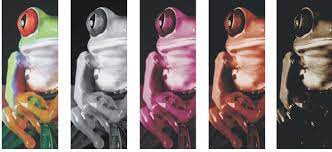The Artistry of Duotones: A Comprehensive Guide to Transforming Bitmaps in CorelDRAW

Introduction:
In the realm of graphic design, the quest for unique and visually captivating styles often leads designers to explore alternative color treatments. One such technique that has gained popularity for its aesthetic appeal is the use of duotones. CorelDRAW, a powerful graphic design software, provides designers with the tools to seamlessly transform bitmaps into duotones, unlocking a realm of creative possibilities. This comprehensive guide delves into the artistry of duotones, exploring the process of changing bitmaps in CorelDRAW to achieve striking and sophisticated visual effects.
Understanding Duotones in Design:
Duotones are a color treatment technique that involves the use of two distinct colors to create depth, contrast, and mood in an image. Unlike traditional full-color images, duotones simplify the color palette, introducing a sense of elegance and artistic flair. The use of duotones is not only visually appealing but also allows designers to convey specific emotions or enhance the overall aesthetics of their designs.
Key Characteristics of Duotones:
- Limited Color Palette:
- Duotones employ only two colors, offering a more restrained and controlled color palette compared to full-color images. This simplicity enhances the visual impact and makes duotones an effective choice for conveying a specific mood or style.
- Contrast and Depth:
- The juxtaposition of two carefully chosen colors in duotones creates enhanced contrast and depth. This can be particularly impactful in highlighting specific elements within an image or drawing attention to key focal points.
- Artistic Expression:
- Duotones provide a canvas for artistic expression, allowing designers to infuse their creations with a unique visual style. The choice of colors, their placement, and the overall tonal balance contribute to the overall aesthetic appeal of the design.
- Timeless Elegance:
- The classic and timeless nature of duotones makes them suitable for a wide range of design applications. From branding and marketing materials to editorial design and digital art, duotones add a touch of elegance and sophistication.
Changing Bitmaps to Duotones in CorelDRAW:
- Open the Bitmap Image:
- Start by opening the bitmap image you wish to transform into a duotone in CorelDRAW. Ensure that the image is selected and ready for editing.
- Access the “Adjust” Menu:
- Navigate to the top menu and select “Adjust” to access a variety of image adjustment options within CorelDRAW.
- Choose “Duotone”:
- Within the “Adjust” menu, locate the option labeled “Duotone.” Selecting this option initiates the process of transforming the bitmap into a duotone.
- Select the Duotone Colors:
- CorelDRAW will prompt you to choose the two colors that will make up the duotone. This step is crucial as it defines the overall look and feel of the transformed image. Designers can select colors from the existing palette or create custom colors.
- Adjust Blend and Tint Options:
- Duotones offer flexibility in adjusting the blend and tint options for the selected colors. Designers can experiment with different blends to achieve the desired transition between the two colors. Tint options allow for further customization of tonal variations.
- Preview Changes and Fine-Tune:
- CorelDRAW provides a preview of the duotone effect, allowing designers to assess how the selected colors interact with the image. Fine-tune the blend, tint, and overall appearance until the desired duotone effect is achieved.
- Confirm and Save:
- Once satisfied with the duotone transformation, confirm the changes. Save the image to preserve the duotone version or continue refining other elements of the design.
Advanced Techniques for Duotones in CorelDRAW:
- Experimenting with Color Combinations:
- Designers can experiment with various color combinations to create unique duotone effects. The choice of colors can significantly impact the mood and style of the design. Consider complementary colors for a harmonious look or contrasting colors for a bold and dynamic effect.
- Adding Texture and Patterns:
- CorelDRAW allows designers to add texture and patterns to duotones, enhancing their visual appeal. Experiment with subtle patterns or overlays to introduce additional depth and complexity to the duotone composition.
- Layering Duotones with Vector Graphics:
- Duotones can be seamlessly integrated with vector graphics in CorelDRAW. Designers can layer duotone images with vector elements, creating intricate compositions that combine the depth of duotones with the scalability of vectors.
- Creating Duotone Effects with Brushes:
- CorelDRAW’s brush tools provide an opportunity to add hand-drawn elements to duotones. Whether emulating brush strokes, ink lines, or paint textures, brushes contribute to the overall expressive quality of duotone designs.
- Utilizing Filters for Artistic Flourishes:
- Filters and effects in CorelDRAW can be applied to duotones for artistic flourishes. Experiment with artistic filters, blurs, or distortions to add a touch of creativity and uniqueness to the duotone composition.
Practical Applications of Duotones in CorelDRAW:
- Branding and Logo Design:
- Duotones offer a sophisticated and memorable approach to branding and logo design. The limited color palette ensures visual consistency and allows brands to convey a distinct visual identity.
- Editorial and Print Design:
- In editorial design, duotones can be employed to create visually striking layouts. From magazine covers to book illustrations, the simplicity and elegance of duotones enhance the overall design aesthetic.
- Digital Art and Illustrations:
- Digital artists and illustrators can use duotones to infuse their creations with a unique visual style. The controlled color palette allows for focused storytelling and artistic expression.
- Social Media Graphics and Marketing Materials:
- Duotones are effective in creating eye-catching social media graphics and marketing materials. Whether for promotional posts, banners, or advertisements, duotones provide a modern and visually appealing design approach.
- Photography and Image Enhancement:
- Photographers can use duotones to enhance the visual impact of their images. The controlled color palette allows for creative experimentation, turning ordinary photographs into captivating visual experiences.
- Web Design and Digital Interfaces:
- Duotones find applications in web design, particularly in creating visually cohesive and impactful digital interfaces. From website backgrounds to UI elements, duotones contribute to a modern and streamlined design aesthetic.
- Art Prints and Posters:
- Duotones are popular choices for art prints and posters. The simplicity and elegance of duotones elevate the visual appeal of artistic creations, making them suitable for various artistic and commercial purposes.
- Product Packaging and Labeling:
- Brands seeking a distinctive and visually appealing packaging design can explore duotones. The controlled color palette ensures that product packaging communicates elegance and stands out on the shelves.
Conclusion:
In conclusion, the artistry of transforming bitmaps into duotones in CorelDRAW opens up a world of creative possibilities for designers. Whether aiming for timeless elegance in branding, creating visually striking editorial layouts, or infusing digital art with a unique visual style, duotones offer a versatile approach to color treatment.
By understanding the process, tools, and advanced techniques explored in this comprehensive guide, designers can confidently integrate duotones into their design repertoire. Embrace the elegance of limited color palettes, experiment with creative flourishes, and let the artistry of duotones redefine the visual language of your designs in CorelDRAW.







